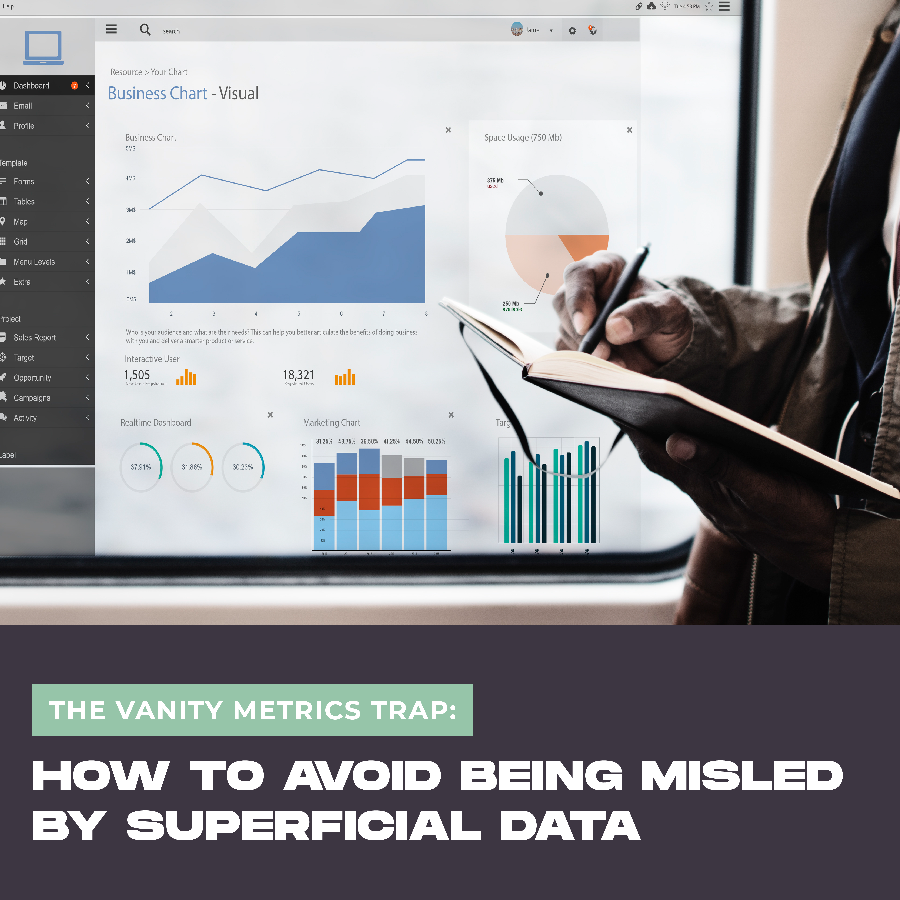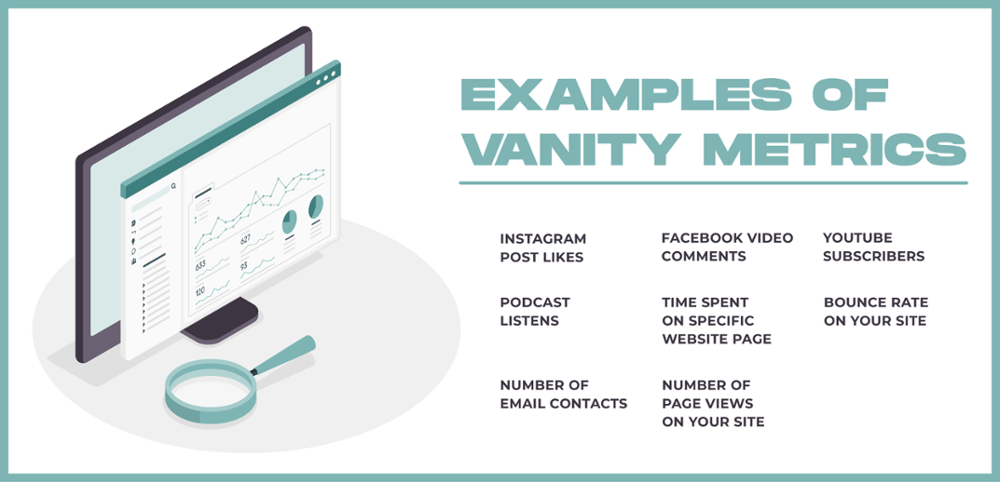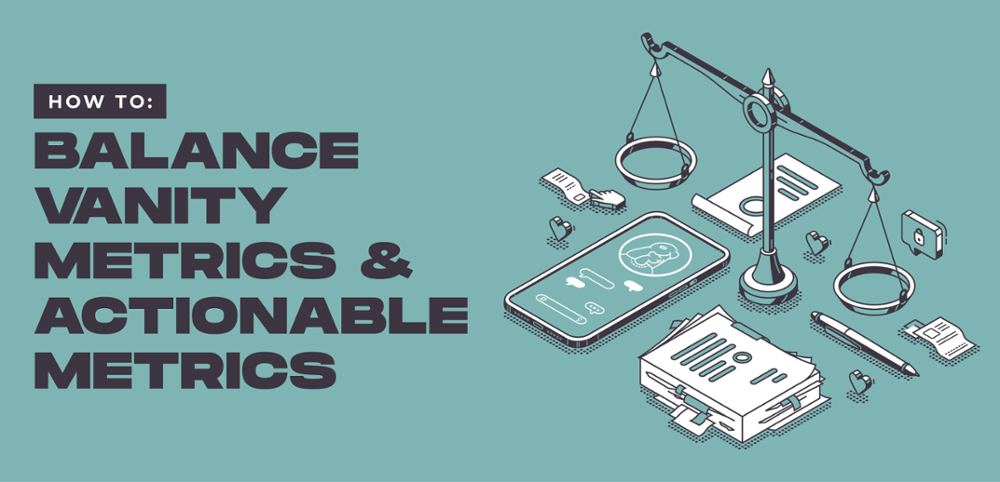Vanity metrics tend to get a lot of negative flack in the digital marketing space.
From social media likes to page views and email subscribers, many digital marketing professionals dismiss vanity metrics because they don’t show a “direct” impact on the bottom line. At LAIRE, we're here to challenge that belief — we believe vanity metrics can serve a purpose.
Keep reading to learn the vanity metrics definition, examples of vanity metrics, why these metrics matter, and how you can balance both vanity metrics and actionable metrics in your everyday marketing initiatives.

What Are Vanity Metrics?
Vanity metrics are a digital marketing metric that tends to look good on the surface but may not be directly correlated to your return on investment (ROI). Because vanity metrics are non-transactional, many marketing professionals tend to disregard them altogether.
So, what do marketing professionals look at, if not vanity metrics? They look to actionable metrics to drive decisions.
Actionable metrics are digital marketing statistics that show how your marketing initiatives directly affect the end bottom line. Examples include conversion rate, click-through rate (CTR), and downloads.
Did your latest Facebook paid ads campaign lead to more conversions, sales, or a boost in lead generation efforts? Did your content offers contribute to more sales? Did you see an increase in clients as a result of offering free discovery calls? That's what actionable metrics are all about.
Examples of Vanity Metrics
Now that we’ve gone over what vanity metrics and actionable metrics are, what are some examples of vanity metrics? Here is a list of common vanity metrics that you may see in your own marketing campaigns:
- Instagram post likes
- Facebook video comments
- YouTube subscribers
- Podcast listens
- Time spent on specific website page
- Bounce rate on your site
- Number of email contacts
- Number of page views on your site

All in all, it’s great to be aware of the different types of metrics so that you can continue to hone in on your company’s digital marketing strategy.
Why Vanity Metrics Matter in Digital Marketing
But LAIRE team… “If vanity metrics don’t always translate to $$$, why do you use them with your clients?”
We’re glad you asked! Here are some of the main advantages of vanity metrics in digital marketing.
Increased Brand Awareness
Vanity metrics provide a big-picture view of brand awareness.
From getting social media shares to getting the conversation pumping in your comments section on your blog, having any form of engagement with your brand improves your overall brand awareness. By seeing what content your audience engages with the most, you can continue creating similar content that could possibly contribute to sales later down the road.
Boosted Morale
Vanity metrics can boost morale and motivation.
It can be a disheartening road to go down if you don’t see any engagement or buzz around your marketing efforts. Having an increase in your vanity metrics is a great signal to your team that their efforts aren’t going to waste. They are the pat on the back that your team needs to keep pushing forward, to keep striving for greatness.
So embrace those likes and shares, revel in the follower count, and let the vanity metrics fuel your team's passion for success.
Better Goal Setting
Let's be real here. Starting from scratch with digital marketing for your business can feel overwhelming. But don't despair — vanity metrics can be your secret weapon for setting initial goals and building momentum.
By leveraging the power of social media likes, website views, and other vanity metrics, you can gain valuable insights into what works and what doesn't. With this historical data at your fingertips, you can create strategic goals that are not only achievable but also informed by your past metrics.
Balancing Vanity Metrics vs Actionable Metrics
It’s important to look at a broad range of data — both vanity and actionable metrics — to get a heartbeat for the effectiveness of your marketing campaigns.
From social media stats to website page conversions to paid ad clicks and more, having a holistic view of all your company’s marketing metrics will be the “secret sauce” to your success.
So, does that mean that you can’t just laser down on vanity metrics?
Why You Can’t Just Rely on Vanity Metrics
Although we love vanity metrics for a variety of reasons, they can become problematic if they are your sole basis for strategic decisions.
Overreliance on vanity metrics can lead to misinterpretation of performance, and they don’t always provide actionable insights for improving marketing strategies. This is why you have to seamlessly marry many types of analytics together to grow your lead generation machine.
How to Balance Vanity Metrics and Actionable Metrics
At our Diamond HubSpot Marketing Agency, we recognize the importance of balancing vanity metrics and actionable metrics. 
This means we won't just report on page views, social media likes, or website impressions. We'll also dig deeper to see how many of those actually translated into valuable customer conversions. Here is an example of what this looks like in action.
Example: Using Vanity Metrics and Actionable Metrics
Say you’re a homebuilder and just launched a digital marketing campaign for "The Ultimate Guide for New Homeowners.” To analyze this specific campaign, you track both landing page views (vanity metric) and the conversion rate (actionable metric).
After analyzing both types of metrics, you then continue to optimize the campaign for more clicks and conversions. Whether that’s changing the language on the landing page form or the design of the content offer itself, digital marketing isn’t a one-and-done type of project. It requires constant changes and reiterations to reap benefits.
By doing this, you’re able to collect comprehensive insights that you can actually use to make better strategic decisions.
While the example above is fictional, we follow this same process — balancing vanity and actionable metrics — for our clients in real life. In this case study, learn how we helped a financial planning firm skyrocket its conversion rate by an impressive 1180%.
Don't settle for vanity alone. Get the full picture and drive real results.
Strike the Perfect Balance With Marketing Analytics
Striking the right balance between vanity metrics and actionable metrics is essential for any successful marketing campaign. While actionable metrics provide insights into the ROI of your marketing efforts, vanity metrics can still serve a purpose in building brand awareness and engagement.
Still, it's crucial to remember that relying solely on one metric over another can be a slippery slope toward misleading and ineffective marketing strategies. By keeping a close eye on both types of metrics, you can make informed decisions and ultimately drive growth for your business.
If you use HubSpot to track and monitor your business’s digital marketing metrics, our free checklist will help you supercharge your portal and unlock its full potential. Get your hands on this checklist now and take the first step toward maximizing your marketing efforts.


